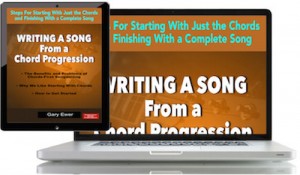As you probably know, I use the term “musical journey” to describe a good song. I like the term mainly because it applies to pop songs that are typically short (3-4 minutes), longer, more intricate songs (5-8 minutes) or even longer prog rock-style song cycles.
So describing any song as a journey is a reminder that there is an important sense of progression that needs to be immediately perceivable, even if on a subconscious level. And I don’t mean progression to mean chords in this context — I’m talking about the sense that one moment in a song leads logically to the next, in much the same way that one part of a real journey leads logically to the next.
 If you like starting songs by working out the chord progression first, you will love “Writing a Song From a Chord Progression.” It’s part of the 10-eBook “Essential Secrets of Songwriting” Bundle.
If you like starting songs by working out the chord progression first, you will love “Writing a Song From a Chord Progression.” It’s part of the 10-eBook “Essential Secrets of Songwriting” Bundle.
When you go on a literal journey — a walk around your town, let’s say — you’re not just hitting all the interesting spots within your town: you’re hitting them in a particular order. It would make no sense to randomly visit the park and then the museum if they’re on opposite sides of the town.
Music is like this. There needs to be a sense that whatever is happening now is being logically followed by something that makes sense — a “logical follower”.
One song that acts as a model to show this sense of progression is Imogen Heap’s “Wait It Out“, a song from her 2009 album “Ellipse.” Give it a listen, and think about the following as you do:
- How does the production/instrumentation change as the song progresses? Think about the pitch range of the instruments: where are the highest notes? Where are the lowest ones? What about rhythmic intensity? What about instrumental technique? You can hear a kind of transparency to the instrumental approach nearer the beginning, with a thickening of sounds by the two-thirds mark.
- Take a look at the lyrics and ask yourself: Is there a noticeable progression in how the lyrics unfold? Like many good lyricists, Heap uses a lot of imagery, metaphor and other poetic devices, sometimes obscuring the obvious meaning of the text. But even if the meaning isn’t obvious, you notice that you get a very clear “because I said this, I’m now going to say that.”
- How do the melodies progress? Think about melodic range, and see if you can notice a basic direction. You should see that there is, in fact, a general sense of melodies moving higher as the song moves along. Think about how this affects the song’s basic energy levels, and you’ll likely conclude that voices moving higher is crucial to this song’s sense of musical energy.
Musical Slices
Here’s something else you can try: Click to listen to “Wait It Out”, and then click quickly along the time line so that you instantly hear how things change. You’ll hear something that sounds like this, a realtime recording of me clicking along the scroll bar at the bottom of a YouTube video:
Try it several times; each time you do that, you hear something new, but no matter what you hear specifically, you get a “snapshot” of the kind of progression we’ve been talking about. In the example above, the first thing you’ll likely notice is that the dynamics (volume) of the music increases until about the two-thirds point, and then gets quieter. That’s part of the overall plan of “Wait It Out,” and it’s an important part of its design.
With your own songs, you should be noticing a similar kind of progression. With every moment in your song, you should have a sense of “because this happened, I then had that happen.” So try clicking along the play scroll bar and give yourself a 5-10 second version of your song. Do you notice a kind of progression?
It’s vital that you notice this kind of progression with your songs’ lyrics. Read your lyrics carefully, and make sure you have a clear idea that “because I said this, I then said that.”
 Written by Gary Ewer. Follow Gary on Twitter
Written by Gary Ewer. Follow Gary on Twitter
“How to Harmonize a Melody” is part of the 10-eBook Deluxe Bundle, written by Gary Ewer. If you can “hear” the chords you want, but you just can’t find them, this ebook will take you step-by-step through a process that works.
Right now get a FREE COPY of “Creative Chord Progressions” with your purchase of that bundle package.











